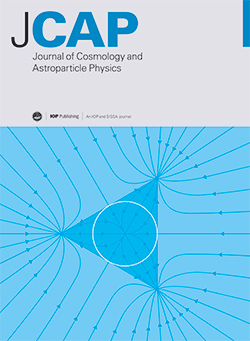Neutrino mass bounds from DESI 2024 are relaxed by Planck PR4 and cosmological supernovae
IF 5.3
2区 物理与天体物理
Q1 ASTRONOMY & ASTROPHYSICS
Journal of Cosmology and Astroparticle Physics
Pub Date : 2024-12-10
DOI:10.1088/1475-7516/2024/12/020
引用次数: 0
Abstract
The recent DESI 2024 Baryon Acoustic Oscillations (BAO) measurements combined with the CMB data from the Planck 18 PR3 dataset and the Planck PR4+ACT DR6 lensing data, with a prior on the sum of the neutrino masses ∑ mν > 0, leads to a strong constraint, ∑ mν < 0.072 eV, which would exclude the inverted neutrino hierarchy and put some tension on even the standard hierarchy. We show that actually this bound gets significantly relaxed when combining the new DESI measurements with the HiLLiPoP + LoLLiPoP likelihoods, based on the Planck 2020 PR4 dataset, and with supernovae datasets. We note that the fact that neutrino masses are pushed towards zero, and even towards negative values, is known to be correlated with the so-called AL tension, a mismatch between lensing and power spectrum measurements in the Planck PR3 data, which is reduced by HiLLiPoP + LoLLiPoP to less than 1σ. We find ∑ mν < 0.1 eV and ∑ mν < 0.12 eV, with the supernovae Pantheon+ and DES-SN5YR datasets respectively. The shift caused by these datasets is more compatible with the expectations from neutrino oscillation experiments, and both the normal and inverted hierarchy scenarios remain now viable, even with the ∑ mν > 0 prior. Finally, we analyze neutrino mass bounds in an extension of ΛCDM that addresses the H0 tension, with extra fluid Dark Radiation, finding that in such models bounds are further relaxed and the posterior probability for ∑ mν begins to exhibit a peak at positive values.来自DESI 2024的中微子质量界限被普朗克PR4和宇宙超新星放宽
最近的DESI 2024重子声学振荡(BAO)测量结合来自普朗克18 PR3数据集和普朗克PR4+ACT DR6透镜数据的CMB数据,在中微子质量总和∑mν > 0的先验条件下,导致∑mν < 0.072 eV的强约束,这将排除反向中微子层次,甚至对标准层次也造成一定的紧张。我们表明,当将新的DESI测量结果与基于普朗克2020 PR4数据集和超新星数据集的HiLLiPoP + LoLLiPoP可能性相结合时,实际上这个界限得到了显着放宽。我们注意到,中微子质量被推向零,甚至负值的事实,已知与所谓的AL张力有关,这是普朗克PR3数据中透镜和功率谱测量之间的不匹配,HiLLiPoP + LoLLiPoP将其减小到小于1σ。我们发现超新星Pantheon+和DES-SN5YR数据集的∑mν < 0.1 eV和∑mν < 0.12 eV。这些数据集引起的位移更符合中微子振荡实验的预期,即使在∑mν >之前,正常和反向分层情景现在仍然可行。最后,我们在求解H0张力的ΛCDM扩展模型中分析了中微子的质量边界,发现在这样的模型中边界进一步放宽,∑mν的后验概率开始在正值处出现峰值。
本文章由计算机程序翻译,如有差异,请以英文原文为准。
求助全文
约1分钟内获得全文
求助全文
来源期刊

Journal of Cosmology and Astroparticle Physics
地学天文-天文与天体物理
CiteScore
10.20
自引率
23.40%
发文量
632
审稿时长
1 months
期刊介绍:
Journal of Cosmology and Astroparticle Physics (JCAP) encompasses theoretical, observational and experimental areas as well as computation and simulation. The journal covers the latest developments in the theory of all fundamental interactions and their cosmological implications (e.g. M-theory and cosmology, brane cosmology). JCAP''s coverage also includes topics such as formation, dynamics and clustering of galaxies, pre-galactic star formation, x-ray astronomy, radio astronomy, gravitational lensing, active galactic nuclei, intergalactic and interstellar matter.
 求助内容:
求助内容: 应助结果提醒方式:
应助结果提醒方式:


